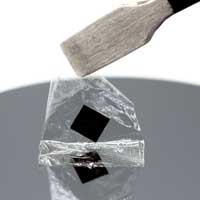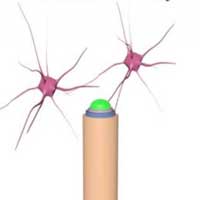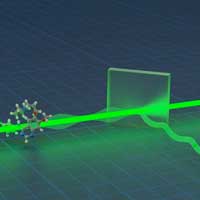 Nanoengineers developed a new method to fabricate perovskites as single-crystal thin films, which are more efficient for use in solar cells and optical devices than the current state-of-the-art polycrystalline forms of the material.
Nanoengineers developed a new method to fabricate perovskites as single-crystal thin films, which are more efficient for use in solar cells and optical devices than the current state-of-the-art polycrystalline forms of the material.
Wednesday, July 29, 2020
New fabrication method brings single-crystal perovskite devices closer to viability
 Nanoengineers developed a new method to fabricate perovskites as single-crystal thin films, which are more efficient for use in solar cells and optical devices than the current state-of-the-art polycrystalline forms of the material.
Nanoengineers developed a new method to fabricate perovskites as single-crystal thin films, which are more efficient for use in solar cells and optical devices than the current state-of-the-art polycrystalline forms of the material.
Tailored light inspired by nature
 Researchers develop for the first time light fields using caustics that do not change during propagation.
Researchers develop for the first time light fields using caustics that do not change during propagation.
Electrochemical doping: researchers improve carbon nanotube transparent conductors
 Researchers have discovered that electrochemical doping with ionic liquid can significantly enhance the optical and electrical properties of transparent conductors made of single-walled carbon nanotube films.
Researchers have discovered that electrochemical doping with ionic liquid can significantly enhance the optical and electrical properties of transparent conductors made of single-walled carbon nanotube films.
Trying to listen to the signal from neurons
 Improved quality of neural recording using a 'coaxial' microneedle-electrode.
Improved quality of neural recording using a 'coaxial' microneedle-electrode.
Gold nanosensor spots difference between dengue, Zika
 A new class of nanosensor could more accurately identify dengue and Zika infections, a task that is complicated by their genetic similarities and which can result in misdiagnosis.
A new class of nanosensor could more accurately identify dengue and Zika infections, a task that is complicated by their genetic similarities and which can result in misdiagnosis.
'Quantum negativity' can power ultra-precise measurements
 Scientists have found that a physical property called 'quantum negativity' can be used to take more precise measurements of everything from molecular distances to gravitational waves.
Scientists have found that a physical property called 'quantum negativity' can be used to take more precise measurements of everything from molecular distances to gravitational waves.
How plantains and carbon nanotubes can improve cars
 The natural plantain fibres are combined with carbon nanotubes and epoxy resin to form a natural fibre-reinforced polymer hybrid nanocomposite material.
The natural plantain fibres are combined with carbon nanotubes and epoxy resin to form a natural fibre-reinforced polymer hybrid nanocomposite material.
Using light to tune interlayer forces in van-der-Waals materials
 Scientists demonstrated for the first time that interlayer coupling in a van der Waals (vdW) material can be largely modulated by a protonic gate, which inject protons to devices from an ionic solid.
Scientists demonstrated for the first time that interlayer coupling in a van der Waals (vdW) material can be largely modulated by a protonic gate, which inject protons to devices from an ionic solid.
Subscribe to:
Posts (Atom)
